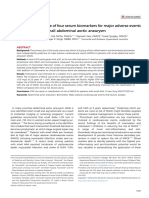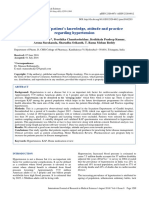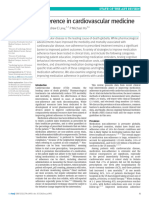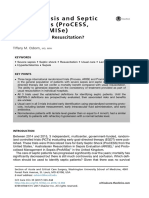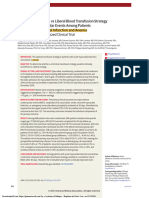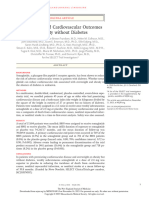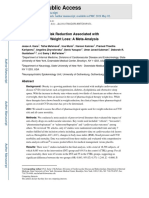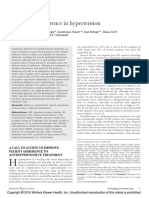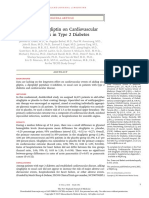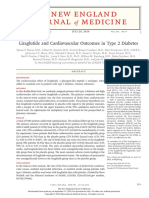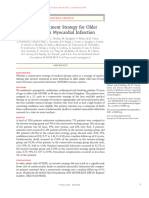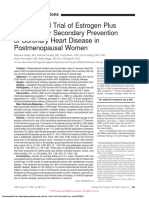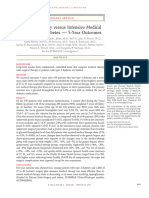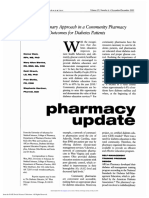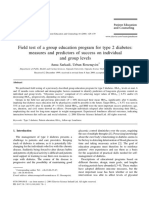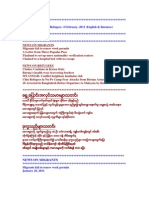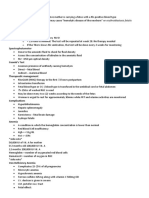Tsuyuki 2002
Tsuyuki 2002
Uploaded by
Basilharbi HammadCopyright:
Available Formats
Tsuyuki 2002
Tsuyuki 2002
Uploaded by
Basilharbi HammadCopyright
Available Formats
Share this document
Did you find this document useful?
Is this content inappropriate?
Copyright:
Available Formats
Tsuyuki 2002
Tsuyuki 2002
Uploaded by
Basilharbi HammadCopyright:
Available Formats
ORIGINAL INVESTIGATION
A Randomized Trial of the Effect
of Community Pharmacist Intervention
on Cholesterol Risk Management
The Study of Cardiovascular Risk Intervention by Pharmacists (SCRIP)
Ross T. Tsuyuki, BSc(Pharm), PharmD, MSc; Jeffrey A. Johnson, BSP, PhD; Koon K. Teo, MB, PhD;
Scot H. Simpson, BSP, PharmD; Margaret L. Ackman, BSc(Pharm), PharmD; Rosemarie S. Biggs, BPharm;
Andrew Cave, MD, MClSc; Wei-Ching Chang, PhD; Vladimir Dzavik, MD; Karen B. Farris, BSPharm, PhD;
Donna Galvin, BSc(Pharm); William Semchuk, MSc, PharmD; Jeff G. Taylor, BSP, PhD;
for the Study of Cardiovascular Risk Intervention by Pharmacists (SCRIP) Investigators
Background: Despite clear evidence for the efficacy of general advice only, with minimal follow-up. The pri-
lowering cholesterol levels, there is a deficiency in its real- mary end point was a composite of performance of a
world application. There is a need to explore alternative fasting cholesterol panel by the physician or addition
strategies to address this important public health prob- or increase in dose of cholesterol-lowering medication.
lem. This study aimed to determine the effect of a pro-
gram of community pharmacist intervention on the pro- Results: The external monitoring committee recom-
cess of cholesterol risk management in patients at high mended early study termination owing to benefit. Of the
risk for cardiovascular events. 675 patients enrolled, approximately 40% were women,
and the average age was 64 years. The primary end point
Methods: A randomized controlled trial conducted in was reached in 57% of intervention patients vs 31% in
54 community pharmacies (1998-2000) included usual care (odds ratio, 3.0; 95% confidence interval, 2.2-
patients at high risk for cardiovascular events (with ath- 4.1; P⬍.001).
erosclerotic disease or diabetes mellitus with another
risk factor). Patients randomized to pharmacist inter- Conclusions: A community-based intervention pro-
vention received education and a brochure on risk fac- gram improved the process of cholesterol management
tors, point-of-care cholesterol measurement, referral to in high-risk patients. This program demonstrates the value
their physician, and regular follow-up for 16 weeks. of community pharmacists working in collaboration with
Pharmacists faxed a simple form to the primary care patients and physicians.
physician identifying risk factors and any suggestions.
Usual care patients received the same brochure and Arch Intern Med. 2002;162:1149-1155
I
N CANADA and the United States, 28% had documentation of serum choles-
approximately 40% of all deaths terol measurement during their hospital
are attributed to cardiovascular admission or within the previous 5 years,
disease, and this is expected to and only 8% were prescribed a cholesterol-
continue to increase with the ag- lowering medication.9 In addition, it seems
ing of society.1,2 The modifiable risk fac- that even patients who are prescribed a
tors for cardiovascular disease are well- cholesterol-lowering medication often
known, and randomized trials have do not reach the recommended target
conclusively demonstrated the efficacy of low-density lipoprotein cholesterol lev-
lowering blood pressure, controlling blood els.16,26,27 This represents a treatment gap
glucose levels, and managing dyslipid- between research evidence and clinical
emia in reducing mortality and morbid- practice that has significant public health
ity from cardiovascular disease.3 implications.
Despite the incontrovertible evi- One reason for this deficiency in ap-
dence of the efficacy of dyslipidemia man- plication of research findings may relate
agement,4-8 our group and others9-25 have to the health care system, which is illness
demonstrated that this evidence is poorly driven rather than prevention driven. A
applied in real-world practice. In a re- survey of 480 Canadian family physi-
Author affiliations are listed at view of 3304 consecutive hospitalized, cians identified several barriers to the pro-
the end of this article. high-risk patients, we observed that only vision of preventive care.28 The most com-
(REPRINTED) ARCH INTERN MED/ VOL 162, MAY 27, 2002 WWW.ARCHINTERNMED.COM
1149
©2002 American Medical Association. All rights reserved.
Downloaded From: http://archinte.jamanetwork.com/ by a Western Oregon University User on 05/25/2015
PARTICIPANTS AND METHODS of coronary artery disease36 or use of insulin or oral hypo-
glycemic medications for the presence of diabetes
mellitus). Written informed consent was obtained from all
Detailed methods of this study have been published previ- participants.
ously (Figure 1).32 The SCRIP was a randomized, mul- Patients were randomized to receive either interven-
ticenter trial comparing a program of pharmacist inter- tion or usual care via a telephone call to the project coordi-
vention with usual care in 54 community pharmacies in nating center, the Epidemiology Coordinating and Re-
the provinces of Alberta and Saskatchewan. Patients were search (EPICORE) Centre, Division of Cardiology, University
approached for entry into the study if they were at high of Alberta. Randomization was conducted via a computer-
risk for cardiovascular events. This included patients with generated sequence using block randomization (block size
atherosclerotic vascular disease, including previous myo- of 4) with stratification by study center (pharmacy). Pa-
cardial infarction, unstable angina, stable angina, coronary tients randomized to the intervention group were inter-
revascularization, or cerebral or peripheral vascular dis- viewed by the pharmacist to obtain complete information
ease. Patients with diabetes mellitus and at least 1 other on their modifiable and nonmodifiable cardiovascular risk
cardiovascular risk factor were also included. This defini- factors. Pharmacists measured the patient’s serum total cho-
tion of high risk is similar to that used in the Heart Out- lesterol level using a point-of-care cholesterol testing de-
comes Prevention Evaluation study34,35 and represents a vice (Accutrend GC; Roche Diagnostics, Laval, Québec). This
group of patients with an annual cardiovascular event rate value was documented and discussed with the patient. Edu-
of at least 5% per year. Patients receiving cholesterol- cation on cardiovascular risk factors was provided by the phar-
lowering drugs were eligible for the study. macist using a patient brochure produced by the Alberta
Patients were excluded if they (1) were currently en- Medical Association and the Clinical Quality Improvement
rolled in a cholesterol study or in a formal cardiac reha- Network. The patient was encouraged to make an appoint-
bilitation program, (2) had a terminal illness that would ment with his or her primary care physician for further car-
preclude them from aggressive cholesterol management, diovascular risk assessment, if necessary. To facilitate this,
or (3) did not provide written informed consent. the pharmacist completed and faxed a single-page form to
Patients were identified by community pharmacists the physician. This form documented the patient’s modifi-
through their knowledge of the patient’s medical history able and nonmodifiable risk factors, medications, serum total
or the use of “indicator” medications, which are markers of cholesterol level, blood pressure, and any suggestions for fur-
high-risk status (eg, use of nitroglycerin for the presence ther testing or management.
cause they are highly accessible and are often the first
Screening by Pharmacist for Patients at
High Risk for Cardiovascular Events point of entry into the health care system. Pharmacists
have computerized records of medications (often includ-
ing information about concurrent disease states) and
675 Randomized
therefore are in an excellent position to recognize pa-
tients at high risk for cardiovascular events, to collabo-
rate with patients and primary care physicians to im-
344 Assigned to Pharmacist 331 Assigned to Usual Care prove cardiovascular care,32,33 and to close the treatment
Intervention gap between research evidence and clinical practice. The
purpose of the Study of Cardiovascular Risk Interven-
12 Withdrew or Were Follow-up Follow-up 6 Withdrew or Were tion by Pharmacists (SCRIP) was to evaluate the effi-
Lost to Follow-up (16 wk) (16 wk) Lost to Follow-up cacy of a program of intervention by community-based
pharmacists to improve the process of cholesterol risk
332 Analyzed for Primary 325 Analyzed for Primary management in patients at high risk for cardiovascular
End Point∗ End Point∗ events.
Figure 1. Trial profile. Asterisk indicates intention-to-treat analysis used.
RESULTS
mon reasons cited for not providing preventive care were The first patient was randomized in the spring of 1998.
that “healthy” patients do not seek preventive care and After a planned review of the first 400 patients, the Ex-
that when patients do visit, priority is given to the pre- ternal Monitoring Committee (see the list at the end of
senting problem. Respondents also believed that pa- the article) recommended early termination of the study
tients may not be interested in or would not comply with because of striking evidence of benefit in the interven-
preventive measures and identified the need for systems tion group compared with the usual care group (using
to alert patients and physicians about the provision of P⬍.0001, set a priori by the committee). By this time, a
preventive care.28 To overcome these barriers, steps must total of 675 patients were recruited by the SCRIP inves-
be taken to educate patients about the benefits of pre- tigators (see the list at the end of the article). Eighteen
ventive cardiovascular care and to provide a reminder sys- patients withdrew or were lost to follow-up (these were
tem for patients and physicians. included in all analyses).
Community pharmacists are well placed to assist in Randomization resulted in a balance of patient de-
the provision of preventive cardiovascular care29-32 be- mographics (Table 1). The average age was about 64
(REPRINTED) ARCH INTERN MED/ VOL 162, MAY 27, 2002 WWW.ARCHINTERNMED.COM
1150
©2002 American Medical Association. All rights reserved.
Downloaded From: http://archinte.jamanetwork.com/ by a Western Oregon University User on 05/25/2015
The intervention group received follow-up visits at 2, assessed using the General Satisfaction With Pharmacy Ser-
4, 8, 12, and 16 weeks. These visits were performed either vices Scale37-39 and the 12-Item Short Form Health Sur-
in person or by telephone (at the discretion of the phar- vey.40,41
macist) and were intended to ensure that the patients had Sample size was estimated assuming a primary event
visited their physician, to provide further education on car- rate of 30% in the control group, as suggested by a previ-
diovascular risk factors, to make further suggestions to the ous study.9 Assuming an increase to 40% in the interven-
patient or physician, to assess and reinforce adherence to tion group, a 2-sided ␣ of .05, and 85% power, a sample
medications, to answer any questions from the patient, and size of 814 patients was estimated. To allow for dropouts
to determine whether study end points had been reached. and loss to follow-up, the sample size was adjusted up-
The final visit (at 16 weeks) was conducted in person to ward to 1000, with 500 patients in each treatment group.
measure the patient’s cholesterol level and blood pressure All analyses were based on intention-to-treat prin-
and to perform close-out procedures. ciples. Primary and secondary dichotomous outcome vari-
Patients randomized to the usual care group received ables were compared between the intervention and usual care
a copy of the same patient information booklet and gen- groups using the Fisher exact test. Planned subgroup analy-
eral advice only. Patients received minimal follow-up, with ses included the effect of the intervention by sex, age, ur-
a telephone call at 8 weeks (to determine outcome events) ban vs rural practice, and presence of diabetes mellitus. The
and a close-out visit at 16 weeks. Breslow-Day test for homogeneity of odds ratios (ORs) was
The primary end point was a composite measure rep- used to compare outcome variables in subgroup analyses.
resenting improvement in the process of cholesterol risk The satisfaction scores were linearly transformed to a scale
management. It consisted of measurement of a complete from 0 to 100 for analysis purposes.42 Change in humanis-
fasting cholesterol panel by the primary care physician or tic outcomes was assessed using analysis of covariance mod-
prescription of a new cholesterol-lowering medication or els. For humanistic outcomes, the 4-month follow-up scores
an increase in dosage of a cholesterol-lowering medica- were used as the dependent variable compared between
tion. As a composite end point, only the first event at- groups, with baseline scores as a covariate. For all analyses,
tained in the cluster was counted. End points were vali- a threshold of statistical significance of P⬍.05 was used.
dated by obtaining a copy of the patient’s laboratory report, The study was approved by the research ethics boards
a copy of the prescription(s), or both. Secondary end points of the University of Alberta, Edmonton; the University of
included individual components of the primary end point Calgary, Calgary, Alberta; and the Regina Health District,
and the humanistic impact of pharmacist intervention, Regina, Saskatchewan.
years, with approximately 40% of patients being women.
About 40% of patients had a history of myocardial in- Table 1. Patient Demographics by Randomized Groups*
farction; 29%, unstable angina; 40%, stable angina; 29%,
Usual Care Intervention
previous revascularization procedures; and 18%, periph- Group Group
eral vascular disease or cerebrovascular disease. Almost Variable (n = 331) (n = 344)
half of the patients enrolled had diabetes mellitus (all
Age, mean ± SD, y 64.6 ± 11.3 64.2 ± 12.2
figures are not mutually exclusive). Females 124 (38) 141 (41)
The primary end point was reached in 196 patients Eligibility†
(57%) in the intervention group vs 102 (31%) in the usual Myocardial infarction 128 (39) 138 (40)
care group (unadjusted OR, 3.0; 95% confidence inter- Unstable angina 95 (29) 97 (28)
val , 2.2-4.1; P⬍.001) (Figure 2). The secondary end Stable angina 140 (42) 131 (38)
point of measurement of a fasting cholesterol panel per- Revascularization 95 (29) 97 (28)
Peripheral vascular disease 54 (16) 65 (19)
formed by the primary care physician was attained in 53% Cerebrovascular disease 59 (18) 61 (18)
of patients in the intervention group vs 29% in usual care Diabetes mellitus + ⱖ1 other 138 (42) 156 (45)
group (OR, 2.8; 95% CI, 2.0-3.7; P⬍.001) (Table 2). risk factors
The end point of new prescription for a cholesterol-
lowering medication was attained in 10% of patients in *All data are given as numbers (percentages) unless otherwise indicated.
the intervention group vs 4% in the usual care group (OR, †Not mutually exclusive.
2.5; 95% CI, 1.3-4.6; P⬍.003) (Table 2). The end point
of increased dose of an existing cholesterol-lowering medi- isfaction scale scores, it seemed that respondents were
cation was attained in 3% of patients in the intervention less satisfied with the communication between their phar-
group vs 1% in the usual care group (OR, 3.0; 95% CI, macist and physician (mean score, 75 of 100) than with
0.99-8.8; P =.07) (Table 2). There was no difference in pharmacy services in general (mean scale score, 84).
the primary end point in subgroups of patients aged ⬍70
vs ⱖ70 years or by urban vs rural pharmacy practices COMMENT
(Table 2). There was a significantly greater effect of the
intervention in women vs men and in patients with dia- The inconsistent application of research evidence into prac-
betes mellitus vs those without (Table 2). tice represents a significant public health problem, espe-
There were no statistically significant changes in cially in the area of cardiovascular disease prevention and
satisfaction with pharmacy services or health status as a treatment.43,44 The results of the SCRIP conclusively dem-
result of the intervention (Table 3). Comparing the sat- onstrate the value of community pharmacist interven-
(REPRINTED) ARCH INTERN MED/ VOL 162, MAY 27, 2002 WWW.ARCHINTERNMED.COM
1151
©2002 American Medical Association. All rights reserved.
Downloaded From: http://archinte.jamanetwork.com/ by a Western Oregon University User on 05/25/2015
tion on the process of cholesterol risk management in pa- cated by the American Heart Association,52 the British Na-
tients at high risk for cardiovascular events. In addition, tional Health Service,53 a joint statement by the Canadian
an economic evaluation, published separately,45 has shown Medical Association and the Canadian Pharmacists’ Asso-
that the marginal cost of providing the intervention (from ciation,54 and others.30,55,56 Pharmacists have successfully
a government payer perspective) is reasonable, approxi- implemented preventive health programs in cholesterol
mately $7 per patient per 4 months. Although the study management,57-61 hypertension,62 and other areas,47,63 but
was terminated early because of benefit, to our knowl- often without comprehensive evaluation. Pharmacists may
edge, the SCRIP is the largest randomized trial of phar- act as a link between the patient and the primary care phy-
macist intervention in cardiovascular disease. sician, thus addressing many of the reported barriers to
The community-based pharmacist has been an preventive care described by Hutchison et al.28
underused resource. In general, patients see their phar- Project ImPACT was a nonrandomized observa-
macists more frequently than other health care provid- tional study61 of pharmacists’ care of patients with hyper-
ers, and because of the nature of their practice, pharma- lipidemia carried out in 26 pharmacies that followed 397
cists are more accessible to the public.29-32 The practice of patients for an average of 24.6 months. They observed
pharmacy has been evolving toward a more clinical, patient- a persistence (refill) rate of 93.6% and a compliance rate
centered (vs product-centered) role during the past de- of 90.1%, with 62.5% of patients achieving National
cade, and evidence of the value of pharmacists’ clinical ac- Cholesterol Education Program goals. The lack of a con-
tivities is beginning to accrue.46-51 The enhanced role of trol group and the fact that only 69% of patients com-
the pharmacist in preventive medicine has been advo- pleted follow-up limit the conclusions that can be drawn
from this study. Shibley and Pugh57 reported on 25 pa-
60 tients managed for 12 months at 2 community pharma-
cies using a before-and-after design. Using point-of-care
50
technology, they reported statistically significant reduc-
40 tions in total and low-density lipoprotein cholesterol lev-
Patients, %
els at 6 and 12 months of follow-up. The main weakness
30
of these 2 studies is the use of a before-and-after design,
20 thus limiting causal inference.
Examination of the separate components of the pri-
10 mary end point shows that most events were attributed
0
to the measurement of a fasting cholesterol profile by the
Usual Care (n = 331) Intervention (n = 344) primary care physician (Table 2). This is not surprising,
Treatment Allocation as it represents an important first step in the process of
Figure 2. Percentage of patients in each group reaching the primary end cholesterol risk management. In a previous study,9 less
point (odds ratio, 3.0; 95% confidence interval, 2.2-4.1; P⬍.001). than one third of high-risk patients had any cholesterol
Table 2. Primary and Secondary Outcomes*
Usual Care Group Intervention Group
Outcome (n = 331) (n = 344) Odds Ratio (95% CI) P Value
Primary end point 102 (31) 196 (57) 3.0 (2.2-4.1) ⬍.001
Secondary end points
Performance of a 96 (29) 181 (53) 2.8 (2.0-3.7) ⬍.001
cholesterol panel
New prescription of a 14 (4) 34 (10) 2.5 (1.3-4.6) ⬍.003
cholesterol-lowering
medication
Increase in dose of 4 (1) 12 (3) 3.0 (0.99-8.8) .07
cholesterol-lowering
medication
Usual Care Group Intervention Group P Value† Odds Ratio (95% CI) P Value‡
Subgroups of primary
end point, No./Total No. (%)
Women 33/124 (27) 88/141 (62) ⬍.001 4.6 (2.7-7.7) .04
Men 69/207 (33) 108/203 (53) ⬍.001 2.3 (1.5-3.4)
Age ⬍70 y 68/216 (32) 126/219 (58) ⬍.001 2.9 (2.0-4.4) .93
Age ⱖ70 y 34/115 (30) 70/125 (56) ⬍.001 3.0 (1.8-5.2)
Urban pharmacy practice 87/281 (31) 170/291 (58) ⬍.001 3.1 (2.2-4.4) .46
Rural pharmacy practice 15/50 (30) 26/53 (49) .070 2.2 (1.0-5.0)
Diabetes mellitus 35/138 (25) 97/156 (62) ⬍.001 4.8 (2.9-8.0) .01
No diabetes mellitus 67/193 (35) 99/187 (53) ⬍.001 2.1 (1.4-3.2)
*Data are given as number (percentage) of patients unless otherwise indicated. CI indicates confidence interval.
†Between the usual care and intervention groups.
‡For heterogeneity of odds ratios between subgroups (eg, females vs males).
(REPRINTED) ARCH INTERN MED/ VOL 162, MAY 27, 2002 WWW.ARCHINTERNMED.COM
1152
©2002 American Medical Association. All rights reserved.
Downloaded From: http://archinte.jamanetwork.com/ by a Western Oregon University User on 05/25/2015
measurement within the past 5 years. By design, this trial In general, respondents were satisfied with pharmacy
entered all high-risk patients regardless of their choles- services at baseline, leaving little room for improvement.
terol level. Not all high-risk patients will require treat- This is not unlike results from previous research38,39,42,65-68
ment for dyslipidemia; however, this will not be known
if cholesterol is not assessed. Although the intervention
group received more prescriptions for cholesterol- Table 3. Changes in Patient Satisfaction With
lowering medications or increases in doses of their cho- Pharmacy Services and Health Status*
lesterol-lowering medication, the absolute number of these
events is relatively few. This too, is not surprising given P
Variable Baseline Follow-up Value†
the short follow-up of the study (4 months) (ie, it may
take longer to properly assess cholesterol, implement General satisfaction with
pharmacy services
nonpharmacologic treatments, and then add or titrate Intervention group 82.8 (18.2) 84.2 (16.5)
medications). .84
Control group 82.3 (18.5) 84.0 (20.0)
It seems that the effect of the intervention was some- Satisfaction with pharmacist-
what greater in women than in men, with relatively fewer physician communication
end points reached in the usual care group (27% in women Intervention group 73.3 (22.5) 75.6 (22.2)
.54
vs 33% in men) and more reached in the intervention Control group 72.7 (23.6) 76.6 (23.1)
Physical health status (PCS12)
groups (62% in women vs 53% in men). Because women Intervention group 39.8 (11.1) 39.2 (11.1)
often receive less cholesterol-lowering therapy,9 this sug- Control group 40.2 (11.3) 41.8 (10.9)
.27
gests that pharmacists should target this population for Mental health status (MCS12)
intervention. By design, about half of the patients en- Intervention group 51.1 (9.5) 51.1 (10.2)
.57
rolled had diabetes mellitus, a major risk factor for car- Control group 51.6 (9.7) 51.3 (9.8)
diovascular events.64 The intervention was about twice
as efficacious in patients with vs without diabetes melli- *Data are given as mean (SD). PCSI2 indicates the physical component
score; MCS12, mental component score.
tus. Again, this suggests that there is much to be gained †From an analysis of covariance model comparing follow-up scores between
by targeting this high-risk group of patients. groups after adjusting for baseline scores.
Study of Cardiovascular Risk Intervention by Pharmacists (SCRIP) Participants
External Monitoring Committee
L. Brent Mitchell, MD (Chairperson) (University of Calgary); Timothy Stratton, PhD, RPh (University of Montana, Mis-
soula); Diane Catellier, DrPh (University of North Carolina, Chapel Hill).
Investigators
Alberta: Donna Galvin and Catherine Biggs (Area Monitors); Apple Drugs, Peace River (Mike Kinshella); Broadmoor Phar-
macy, Sherwood Park (Catherine Biggs and Rosemarie Biggs); Co-op Pharmacy, Red Deer (Gordon Matthies, Gloria Wright,
and Susan Proctor); Crescent Rexall, Edmonton (Sylvie Généreux and Karen Schultz); Crestwood Apothecary, Edmonton
(Mike Wolowyk); Grandin Prescription Center, St Albert (Merose Stelmaschuk, Carolyn Eastwick, and Karen Dyck); Medi-
cine Shoppe, 118th Avenue, Edmonton (Laurie Reay and Michelle VanDerMolen); Medicine Shoppe, Fort Saskatchewan
(Mark Sigurdson); Medicine Shoppe, Meadowlark, Edmonton (Terese Tsuruda); Medicine Shoppe, Whitemud Crossing,
Edmonton (Pam Lavold); Myros Pharmacy, Edmonton (Dwayne Samycia and Mohib Samnani); Nolan Drugs, Edmonton
(Zaher Samnani); Shoppers Drug Mart, Heritage Square, Edmonton (Roland Coppens); Shoppers Drug Mart, Kingsway Gar-
den Mall, Edmonton (Rick Hackman, Anita Brown, and Pam Davis); Shoppers Drug Mart, Riverbend Square, Edmonton
(Paul Readman, Eric Yu, and Robert Wojtas); Shoppers Drug Mart, Sherwood Park (Sandy Campbell and Catherine Cheva-
lier); Shoppers Drug Mart, Tudor Glen Market, St Albert (Holly Paget, Shawn Cripps, and Jody Shkrobot); Shoppers Drug
World, Edmonton (Donald Makowichuck); Southgate Mall Rexall, Edmonton (Willi Wangert and Joel Ghitter); Value Drug
Mart, Devon (Dave Burwash); Value Drug Mart, Peace River (Patrick Kinshella and Vanda Bilous-Kinshella); Britannia Phar-
macy, Calgary (Debbie Boyle); Central Care Medical Pharmacy, Calgary (Dean Myers); Kenron Pharmacy, Calgary (Martha
Nystrom, Kim Johnson, Tamara Bresee, and Adrian Azim); Professional Centre Pharmacy, Calgary (Audrey Fry); Safeway,
Centre Street, Calgary (Jenny Mancenido and Kee Goh); Safeway, Montgomery, Calgary (Nadine Velasco, Tracy Marsden,
and Don Wickford); Safeway, North Hill, Calgary (Betty Wishloff, Michelle Borysko, and Rishma Damji); Safeway, South-
land, Calgary (Kathy Hayward, Ian Churchill, Dana Fraser, and Noorani Ramji); Safeway, Westbrook, Calgary (Todd Read);
Shoppers Drug Mart, Northland Drive, Calgary (Don Saby and Marlene Gukert); Signature Drugs, Calgary (Susan Young-
gren); Telstar Drug Ltd, Calgary (Olga Dmytrisin). Saskatchewan: Bill Semchuk and Arlene Kuntz (Area Monitors); College
Avenue Drugs, Regina (Jack Mullock and Michelle Lesy); Co-op Pharmacy, Meadow Lake (Linda LaBar); COSTCO Phar-
macy, Regina (Ed Toth, Cynthia Wegner, and Susan Wasylyshyn); Estevan Pharmasave, Estevan (Rob Rogers and David
Jeske); Lorne Drugs, Regina (Chris Perentes and Rhonda Woods); Melfort Pharmasave, Melfort (Kirk Spicer and Darren
Thirsk); Moose Jaw Pharmasave, Moose Jaw (Lena Hartman and Patricia Giesinger); Prescription Plus, General Hospital,
Regina (Chris Semenchuck); Shaunavon Pharmasave, Shaunavon (Leigh Fehr-Little and Bruce Pearson); Shoppers Drug Mart,
Gordon Road, Regina (Wendy Davidson and Spiro Kolitsas); Shoppers Drug Mart, Normanview Mall, Regina (Scott Szabo,
Myra Allen, and Cathy Klatt); Shoppers Drug Mart, Park Street, Regina (Arlene Kuntz, Pat Laturnas, Sherry Gray, and Tom
Chen); Shoppers Drug Mart, Victoria Square, Regina (Darla Cook and Carol Pannell); Townsend’s Central Drugs, Wynyard
(Dallas Townsend and Kendra Townsend); Wakaw Pharmacy, Wakaw (Mike Stan and Colette Stan); Wynyard Pharmacy,
Wynyard (Walter Peterson).
(REPRINTED) ARCH INTERN MED/ VOL 162, MAY 27, 2002 WWW.ARCHINTERNMED.COM
1153
©2002 American Medical Association. All rights reserved.
Downloaded From: http://archinte.jamanetwork.com/ by a Western Oregon University User on 05/25/2015
and may also reflect the selection of highly motivated We thank the pharmacists who volunteered their time
pharmacists (a ceiling effect). In contrast, respondents to participate in this study; Catherine Biggs, BSc(Pharm),
seemed to be less satisfied with communication be- and Arlene Kuntz, BSP, for helping to coordinate study sites;
tween pharmacists and physicians, with no improve- and Marilou Hervas-Malo, MSc, for conducting some of the
ments in the intervention group. It is unclear why pa- statistical analyses.
tients did not perceive any difference in the service Corresponding author and reprints: Ross T. Tsuyuki,
provided, since the interaction between health profes- BSc(Pharm), PharmD, MSc, Epidemiology Coordinating
sionals was an integral part of the intervention. It is likely and Research (EPICORE) Centre, Division of Cardiology,
that patients were not aware of the degree of communi- University of Alberta, 213 Heritage Medical Research
cation that occurred and therefore could not base any Centre, Edmonton, Alberta, Canada T6G 2S2 (e-mail: ross
assessment of satisfaction on the enhanced level of .tsuyuki@ualberta.ca).
care. Further research on this topic is required, perhaps
addressing the expectations of pharmacy services as an REFERENCES
antecedent to satisfaction.37,69
The limitations of the present study have been out- 1. Wielgosz A, Arango M, Carew M, et al, eds. The Changing Face of Heart Disease
lined elsewhere.32 Briefly, a possible limitation of this study and Stroke in Canada, 2000. Ottawa, Ontario: Heart and Stroke Foundation of
is that it measured process rather than clinical out- Canada; 1999.
comes. Given the weight of evidence for efficacy of cho- 2. Heart and Stroke Statistics. Dallas, Tex: American Heart Association; 1998.
3. Forrester JS, Merz CNB, Bush TL, et al. 27th Bethesda Conference: matching the
lesterol-lowering therapy, it would be inappropriate (and
intensity of risk factor management with the hazard for coronary disease events:
impractical) to follow patients to the point of clinical out- Task Force 4: efficacy of risk factor management. J Am Coll Cardiol. 1996;27:
comes. Furthermore, it is well accepted that process out- 991-1006.
comes are appropriate for trials of health care delivery 4. Scandinavian Simvastatin Survival Study Group. Randomised trial of choles-
and in fact are considered more sensitive indicators of terol lowering in 4444 patients with coronary heart disease: the Scandinavian
Simvastatin Survival Study (4S). Lancet. 1994;344:1383-1389.
quality than clinical outcomes because poor outcomes 5. Shepherd J, Cobbe SM, Ford I, et al. Prevention of coronary heart disease with
do not always result from poor processes.70 The SCRIP pravastatin in men with hypercholesterolemia. N Engl J Med. 1995;333:1301-
was performed by highly selected pharmacists, thus rais- 1307.
ing the issue of the generalizability of our findings. Fi- 6. Sacks FM, Pfeffer MA, Moye LA, et al. The effect of pravastatin on coronary events
after myocardial infarction in patients with average cholesterol levels. N Engl
nally, the current health care system, which focuses on
J Med. 1996;335:1001-1009.
product delivery and acute care, makes such compre- 7. Downs JR, Clearfield M, Weis S, et al, for the AFCAPS/TexCAPS Research Group.
hensive programs difficult (although not impossible). Primary prevention of acute coronary events with lovastatin in men and women
This study was conceived to address a major public with average cholesterol levels: results of AFCAPS/TexCAPS. JAMA. 1998;279:
health problem and a treatment gap between research evi- 1615-1622.
8. The Long-term Intervention with Pravastatin in Ischemic Disease (LIPID) Study
dence and clinical practice. It provides proof of concept Group. Prevention of cardiovascular events and death with pravastatin in pa-
that community pharmacists, working in partnership with tients with coronary heart disease and a broad range of initial cholesterol levels.
patients and primary care physicians, can have a major N Engl J Med. 1998;339:1349-1357.
beneficial impact on cholesterol risk management. It is 9. The Clinical Quality Improvement Network (CQIN) Investigators. Low incidence
of assessment and modification of risk factors in acute care patients at high risk
hoped that these methods can be adapted for use in other
for cardiovascular events, particularly among females and the elderly. Am J Car-
disease states as another tool in our quest to provide the diol. 1995;76:570-573.
best care to the patients we serve. 10. Boekeloo BO, Becker DM, LeBailly A, Pearson TA. Cholesterol management in
patients hospitalized for coronary heart disease. Am J Prev Med. 1988;4:128-
Accepted for publication September 25, 2001. 132.
11. Northridge DB, Shandall A, Rees A, Buchalter MB. Inadequate management of
From the Division of Cardiology (Drs Tsuyuki, Simp- hyperlipidaemia after coronary bypass surgery shown by medical audit. Br Heart
son, Chang, and Dzavik) and the Departments of Family J. 1994;72:466-467.
Medicine (Dr Cave) and Public Health Sciences (Dr Johnson), 12. ASPIRE Steering Group. A British Cardiac Society survey of the potential for the
Faculty of Medicine and Dentistry, and the Faculty of Phar- secondary prevention of coronary disease: ASPIRE (Action on Scondary Pre-
vention through Intervention to Reduce Events). Heart. 1996;75:334-342.
macy and Pharmaceutical Sciences (Dr Johnson), Univer- 13. Bramlet DA, King H, Young L, Witt JR, Stoukides CA, Kaul AF. Management of
sity of Alberta, Edmonton; the Division of Cardiology, hypercholesterolemia: practice patterns for primary care providers and cardi-
McMaster University, Hamilton, Ontario (Dr Teo); Re- ologists. Am J Cardiol. 1997;80(suppl):39H-44H.
gional Pharmacy Services, Capital Health, Edmonton (Dr 14. McBride P, Schrott HG, Plane MB, Underbakke G, Brown RL. Primary care prac-
Ackman); Broadmoor Pharmacy, Sherwood Park, Alberta tice adherence to National Cholesterol Education Program guidelines for pa-
tients with coronary heart disease. Arch Intern Med. 1998;158:1238-1244.
(Ms Biggs); the College of Pharmacy, The University of Iowa, 15. Frolkis JP, Zyzanski SJ, Schwartz JM, Suhan PS. Physician noncompliance with
Iowa City (Dr Farris); CPS Consultants, Okotoks, Alberta the 1993 National Cholesterol Education Program (NCEP-ATPII) guidelines. Cir-
(Ms Galvin); the Pharmacy Department, Regina Health culation. 1998;98:851-855.
District, Regina, Saskatchewan (Dr Semchuk); and the Col- 16. Sueta C, Chowdhury M, Boccuzzi SJ, et al. Analysis of the degree of undertreat-
ment of hyperlipidemia and congestive heart failure secondary to coronary ar-
lege of Pharmacy and Nutrition, University of Saskatchewan, tery disease. Am J Cardiol. 1999;83:1303-1307.
Saskatoon (Dr Taylor). A complete list of the SCRIP inves- 17. Majumdar SR, Gurwitz JH, Soumerai SB. Undertreatment of hyperlipidemia in
tigators appears in a box on page 1153. the secondary prevention of coronary artery disease. J Gen Intern Med. 1999;
This study was supported by unrestricted grants from 14:711-717.
The University Hospital Foundation (Edmonton), Merck 18. Watt P, Becker DM, Salaita K, Pearson TA. Hypercholesterolemia in patients un-
dergoing coronary bypass surgery: are they aware, under treatment, and under
Frosst Canada Ltd (Kirkland, Québec), The Alberta Col- control? Heart Lung. 1988;17:205-208.
lege of Pharmacists (Edmonton), and The Institute of Health 19. Madlon-Kay DJ. Family physician recognition and treatment of severe hypercho-
Economics (Edmonton). lesterolemia. J Fam Pract. 1987;24:54-56.
(REPRINTED) ARCH INTERN MED/ VOL 162, MAY 27, 2002 WWW.ARCHINTERNMED.COM
1154
©2002 American Medical Association. All rights reserved.
Downloaded From: http://archinte.jamanetwork.com/ by a Western Oregon University User on 05/25/2015
20. Cohen MV, Byrne M, Levine B, Gutowski T, Adelson R. Low rate of treatment of failure: community standards and the post-discharge patient. Am J Cardiol. 1997;
hypercholesterolemia by cardiologists in patients with suspected and proven coro- 80(suppl):45H-52H.
nary artery disease. Circulation. 1991;83:1294-1304. 45. Simpson SH, Johnson JA, Tsuyuki RT. Economic evaluation of the Study of Car-
21. Giles WH, Anda RF, Jones DH, Serdula MK, Merritt RK, DeStefano F. Recent trends diovascular Risk Intervention by Pharmacists (SCRIP). Pharmacotherapy. 2001;
in the identification and treatment of high blood cholesterol by physicians: progress 21:627-635.
and missed opportunities. JAMA. 1993;269:1133-1138. 46. Hepler CD, Strand LM. Opportunities and responsibilities in pharmaceutical care.
22. Schrott HG, Bittner V, Vittinghoff E, Herrington DM, Hulley S. Adherence to na- Am J Hosp Pharm. 1990;47:533-543.
tional cholesterol education program treatment goals in postmenopausal women 47. Lipton HL, Byrns PJ, Soumerai S, Chrischilles EA. Pharmacists as agents of change
with heart disease: the Heart and Estrogen/Progestin Replacement Study (HERS). for rational drug therapy. Intl J Technol Assess Health Care. 1995;11:485-508.
JAMA. 1997;277:1281-1286. 48. Hatoum HT, Akhras K. 1993 bibliography: a 32-year literature review on the value
23. Hoerger TJ, Bala MV, Bray JW, Wilcosky TC, LaRosa J. Treatment patterns and and acceptance of ambulatory care provided by pharmacists. Ann Pharmaco-
distribution of low-density lipoprotein cholesterol levels in treatment-eligible United ther. 1993;27:1106-1119.
States adults. Am J Cardiol. 1998;82:61-65. 49. Tett SE, Higgins GM, Armour CL. Impact of pharmacist interventions on medi-
24. McCormick D, Gurwitz JH, Lessard D, Yarzebski J, Gore JM, Goldberg RJ. Use cation management by the elderly: a review of the literature. Ann Pharmacother.
of aspirin, -blockers, and lipid-lowering medications before recurrent acute myo- 1993;27:80-86.
cardial infarction: missed opportunities for prevention? Arch Intern Med. 1999; 50. Soumerai SB, Avorn J. Principles of educational outreach (academic detailing)
159:561-567. to improve clinical decision making. JAMA. 1990;263:549-556.
25. Lai LL, Poblet M, Bello C. Are patients with hyperlipidemia being treated? South 51. Schumock GT, Meek PD, Ploetz PA, Vermeulen LD. Economic evaluations of clini-
Med J. 2000;93:283-286. cal pharmacy services: 1988-1995. Pharmacotherapy. 1996;16:1188-1208.
26. Jacobson TA, Griffiths GG, Varas C, Gause D, Sung JC, Ballantyne CM. Impact 52. Pearson TA, Brown WV, Donato K, et al. Lipids: workshop IV: AHA Prevention
of evidence-based “clinical judgment” on the number of American adults requir-
Conference III: behavior change and compliance: keys to improving cardiovas-
ing lipid-lowering therapy based on updated NHANES III data. Arch Intern Med.
cular health. Circulation. 1993;88:1397-1401.
2000;160:1361-1369.
53. Great Britain Department of Health and Social Security. Promoting Better Health:
27. Pearson TA, Laurora I, Chu H, Kafonek S. The Lipid Treatment Assessment Project
The Government’s Programme for Improving Primary Health Care. London, En-
(L-TAP). Arch Intern Med. 2000;160:459-467.
gland: Her Majesty’s Stationary Office; 1987. Cm. No. 249.
28. Hutchison BG, Abelson J, Woodward CA, Norman G. Preventive care and barri-
54. Approaches to enhancing the quality of drug therapy: a joint statement by the
ers to effective prevention: how do family physicians see it? Can Fam Physician.
CMA and the Canadian Pharmacists’ Association. CMAJ. 1996;155:784A-784F.
1996;42:1693-1700.
55. Spencer JA, Edwards C. Pharmacy beyond the dispensary: general practition-
29. The AltiMed CFP Report on Pharmacy Services 1997: Consumer Perceptions of
ers’ views. BMJ. 1992;304:1670-1672.
Pharmacy. Toronto, Ontario: AltiMed; 1997.
56. Paluck EC, Stratton TP, Eni GO. Community pharmacists’ participation in health
30. Ford S, Jones K. Integrating pharmacy fully into the primary care team: much to
education and disease prevention activities. Can J Public Health. 1994;85:389-
recommend it. BMJ. 1995;310:1620-1621.
392.
31. Rawlins MD. Extending the role of the community pharmacist . BMJ. 1991;302:
427-428. 57. Shibley MCH, Pugh CB. Implementation of pharmaceutical care services for pa-
32. Tsuyuki RT, Johnson JA, Teo KK, et al, for the SCRIP Investigators. Study of tients with hyperlipidemias by independent community pharmacy practitioners.
Cardiovascular Risk Intervention by Pharmacists (SCRIP): randomized trial de- Ann Pharmacother. 1997;31:713-719.
sign of the effect of a community pharmacist intervention program on serum 58. Einarson TR, Bootman JL, McGhan WF, Larson LN, Gardner ME, Donohue M.
cholesterol risk. Ann Pharmacother. 1999;33:910-919. Establishment and evaluation of a serum cholesterol monitoring service in a com-
33. Gardner SF, Skelton DR, Rollins SD, Hastings JK. Community pharmacy data munity pharmacy. Drug Intell Clin Pharm. 1988;22:45-48.
bases to identify patients at high risk for hypercholesterolemia. Pharmaco- 59. Bogden PE, Koontz LM, Williamson P, Abbott RD. The physician and pharma-
therapy. 1995;15:292-296. cist team: an effective approach to cholesterol reduction. J Gen Intern Med. 1997;
34. The HOPE Study Investigators. The HOPE (Heart Outcomes Prevention Evalua- 12:158-164.
tion) study: the design of a large, simple randomized trial of an angiotensin- 60. Madejski RM, Madejski TJ. Cholesterol screening in a community pharmacy.
converting enzyme inhibitor (ramipril) and vitamin E in patients at high risk of J Am Pharm Assoc (Wash). 1996;NS36:243-248.
cardiovascular events. Can J Cardiol. 1996;12:127-137. 61. Bluml BM, McKenney JM, Cziraky MJ. Pharmaceutical care services and results
35. The Heart Outcomes Prevention Evaluation Study Investigators. Effects of an an- in project ImPACT: hyperlipidemia. J Am Pharm Assoc (Wash). 2000;40:157-
giotensin-converting enzyme inhibitor, ramipril, on death from cardiovascular 165.
causes, myocardial infarction, and stroke in high-risk patients. N Engl J Med. 62. Park JJ, Kelly P, Carter BL, Burgess PP. Comprehensive pharmaceutical care in
2000;343:145-153. the chain setting. J Am Pharm Assoc (Wash). 1996;36:443-451.
36. Tsuyuki RT, Olson KL, Teo KK. Nitroglycerin as an indicator for the presence of 63. Munroe WP, Kunz K, Dalmady-Israel C, Potter L, Schonfeld WH. Economic evalu-
coronary heart disease. Can Pharm J. 1999;132:32-36. ation of pharmacist involvement in disease management in a community phar-
37. Johnson JA, Coons SJ, Hays RD. The structure of satisfaction with pharmacy macy setting. Clin Ther. 1997;19:113-123.
services. Med Care. 1998;36:244-250. 64. Grundy SM, Benjamin IJ, Burke GL, et al. Diabetes and cardiovascular disease:
38. Larson LN, MacKeigan LD. Further validation of an instrument to measure pa- a statement for healthcare professionals from the American Heart Association.
tient satisfaction with pharmacy services. J Pharm Market Manage. 1994;8:125- Circulation. 1999;100:1134-1146.
139. 65. Fincham JE, Wertheimer AI. Predictors of patient satisfaction with pharmacy ser-
39. MacKeigan LD, Larson LN. Development and validation of an instrument to mea- vices in a health maintenance organization. J Pharm Market Manage. 1987;2:
sure patient satisfaction with pharmacy services. Med Care. 1989;27:522-536. 73-88.
40. Ware JE, Kosinski M, Keller SD. A 12-Item Short Form Health Survey: construc- 66. Mackowiak JI, Manasse HH. Expectation vs demand for pharmacy services.
tion of scales and preliminary tests of reliability and validity. Med Care. 1996; J Pharm Market Manage. 1988;2:57-72.
34:220-233. 67. Birtcher KK, Shepherd MD. Users’ perceptions of mail-service pharmacy. Am
41. Stewart AL, Ware JE, eds. Measuring Functioning and Well-being: The Medical Pharm. 1992;NS32:35-41.
Outcomes Study Approach. Durham, NC: Duke University Press; 1992. 68. Smith HA, Coons SJ. Patron experience and satisfaction with pharmaceutical ser-
42. Johnson JA, Coons SJ, Hays RD, Sabers D, Jones P, Langley PC. A comparison vices. J Pharm Market Manage. 1993;7:81-93.
of satisfaction with mail and traditional pharmacy services. J Manage Care Pharm. 69. Janelli PL, Coward RT. Communication between pharmacists and patients: the
1997;3:327-337. role of place of residence in determining the expectation of older adults. Phar-
43. King KM, Bungard TJ, McAlister FA, et al. Quality improvement for CQI. Prev Med macotherapy. 1997;17:148-162.
Managed Care. 2000;1:129-137. 70. Brook RH, McGlynn EA, Cleary PD. Quality of health care, part 2: measuring qual-
44. Pearson TA, Peters TD. The treatment gap in coronary artery disease and heart ity of care. N Engl J Med. 1996;335:966-969.
(REPRINTED) ARCH INTERN MED/ VOL 162, MAY 27, 2002 WWW.ARCHINTERNMED.COM
1155
©2002 American Medical Association. All rights reserved.
Downloaded From: http://archinte.jamanetwork.com/ by a Western Oregon University User on 05/25/2015
You might also like
- MFD Part 2 RCSI Past Questions With Answers by Lubna AlmuzianDocument18 pagesMFD Part 2 RCSI Past Questions With Answers by Lubna AlmuzianEnea Nastri100% (4)
- MCU 2015 ERS Practical Handbook of Noninvasive VentilationDocument320 pagesMCU 2015 ERS Practical Handbook of Noninvasive VentilationAlina CiubotariuNo ratings yet
- VSIM Clinical Worksheet 07.10.2020Document6 pagesVSIM Clinical Worksheet 07.10.2020Jackie Griffis100% (1)
- Cognitive Behavior Therapy For Adolescents With Eating Disorders (Riccardo Dalle Grave Simona Calugi) (Z-Library)Document363 pagesCognitive Behavior Therapy For Adolescents With Eating Disorders (Riccardo Dalle Grave Simona Calugi) (Z-Library)Violeta StefanNo ratings yet
- Counseling 610 Final Project - Case ConceptualizationDocument10 pagesCounseling 610 Final Project - Case ConceptualizationRyan McDonald100% (3)
- Abstracts: Nephrology Dialysis TransplantationDocument1 pageAbstracts: Nephrology Dialysis TransplantationrezkyfikriNo ratings yet
- Gender Factor Effects On Compliance of Statin Therapy in Hyperlipidemia PatientsDocument3 pagesGender Factor Effects On Compliance of Statin Therapy in Hyperlipidemia Patientsparus.saleemNo ratings yet
- E2 Journal of Hypertension Vol 35, E-Supplement 3, November 2017Document1 pageE2 Journal of Hypertension Vol 35, E-Supplement 3, November 2017Sadam_fasterNo ratings yet
- Clortalidona Vs HCLDocument10 pagesClortalidona Vs HCLdiana stefhany marin ramirezNo ratings yet
- The Predictive Value of Four Serum Biomarkers ForDocument8 pagesThe Predictive Value of Four Serum Biomarkers Forsebasags19No ratings yet
- Nej Mo A 2307563Document12 pagesNej Mo A 2307563Sussette SánchezNo ratings yet
- Systematic Review and Meta-Analysis of Medication Reviews Cardiovascular DeseasesDocument35 pagesSystematic Review and Meta-Analysis of Medication Reviews Cardiovascular DeseasesjlizpinedaNo ratings yet
- Cardiovascular and Renal Outcomes With Efpeglenatide in Type 2 DiabetesDocument12 pagesCardiovascular and Renal Outcomes With Efpeglenatide in Type 2 DiabetesAntonella Angulo CruzadoNo ratings yet
- Cardiovascular and Renal Outcomes With Efpeglenatide in Type 2 DiabetesDocument12 pagesCardiovascular and Renal Outcomes With Efpeglenatide in Type 2 DiabetesMoeez AkramNo ratings yet
- Reducing Inappropriate Polypharmacy The Process of DeprescribingDocument8 pagesReducing Inappropriate Polypharmacy The Process of DeprescribingThiago SartiNo ratings yet
- LeaderDocument12 pagesLeaderMoeez AkramNo ratings yet
- Assessment of Patient's Knowledge, Attitude and Practice Regarding HypertensionDocument6 pagesAssessment of Patient's Knowledge, Attitude and Practice Regarding HypertensionScintya NasutionNo ratings yet
- 2008-Predictive Validity of A Medication Adherence Measure in An Outpatient Setting PDFDocument7 pages2008-Predictive Validity of A Medication Adherence Measure in An Outpatient Setting PDFRizki RomadhonNo ratings yet
- Treatment of Cholesterol in 2017Document2 pagesTreatment of Cholesterol in 2017Bruno Andre Garcia VegaNo ratings yet
- 12.glycemia Reduction in Type 2 DiabetesDocument14 pages12.glycemia Reduction in Type 2 DiabetesEdilberto Pérez ManturanoNo ratings yet
- White NEJM Examine Sep13Document9 pagesWhite NEJM Examine Sep13Kamalia LayalNo ratings yet
- Drug-Related Problems in Hypertensive Patients With Multiple ComorbiditiesDocument8 pagesDrug-Related Problems in Hypertensive Patients With Multiple ComorbiditiesHIDAYATNo ratings yet
- bmj.n1493.fullDocument19 pagesbmj.n1493.fullMouhammad Al-awadNo ratings yet
- Osborn 2017Document22 pagesOsborn 2017uci 2No ratings yet
- Cardiovascular and Renal Outcomes With Empagliflozin in Heart FailureDocument12 pagesCardiovascular and Renal Outcomes With Empagliflozin in Heart FailureSandra PargaNo ratings yet
- Dapagliflozin and Cardiovascular Outcomes in Type 2 DiabetesDocument12 pagesDapagliflozin and Cardiovascular Outcomes in Type 2 DiabetesAlina PopaNo ratings yet
- Article 9Document10 pagesArticle 9vzwsvt7hgkNo ratings yet
- Semaglutide and Cardiovascular Outcomes in Obesity Without DiabetesDocument12 pagesSemaglutide and Cardiovascular Outcomes in Obesity Without Diabetesmengyanli.528No ratings yet
- Nihms 1020972Document11 pagesNihms 1020972Carlos Alfredo Pedroza MosqueraNo ratings yet
- Bloomgarden Z Diab Care 2008 - 31 - p.1913Document7 pagesBloomgarden Z Diab Care 2008 - 31 - p.1913KARINA MOREIRANo ratings yet
- Gota PDFDocument11 pagesGota PDFMedicina InternaNo ratings yet
- GOramondbDocument5 pagesGOramondbmito leeNo ratings yet
- Chlorthalidone vs. Hydrochlorothiazidefor Hypertension-Cardiovascular EventsDocument10 pagesChlorthalidone vs. Hydrochlorothiazidefor Hypertension-Cardiovascular EventsPedro ufNo ratings yet
- Nej Mo A 2410027Document11 pagesNej Mo A 2410027arthurrodrigues27rjNo ratings yet
- Adherence To Cardiovascular Therapy: A Meta-Analysis of Prevalence and Clinical ConsequencesDocument9 pagesAdherence To Cardiovascular Therapy: A Meta-Analysis of Prevalence and Clinical Consequencesdaniela NeculmanNo ratings yet
- ESCAPE Study - JAMA 2005Document9 pagesESCAPE Study - JAMA 2005MICHAEL AMARILLO CORREANo ratings yet
- WH Elton 1998Document9 pagesWH Elton 1998cifa parinussaNo ratings yet
- Adhrence 1Document9 pagesAdhrence 1nabilahbilqisNo ratings yet
- Nej Mo A 1912388Document9 pagesNej Mo A 1912388dralourdesreyespediatraNo ratings yet
- Pharmacists Get to the Heart of the Matter 2019 JaDocument2 pagesPharmacists Get to the Heart of the Matter 2019 JaCintia ValériaNo ratings yet
- Type 2 Diabetes: Assessing The Relative Risks and Benefits of Glucose-Lowering MedicationsDocument10 pagesType 2 Diabetes: Assessing The Relative Risks and Benefits of Glucose-Lowering MedicationsmosabNo ratings yet
- Carson 2011Document10 pagesCarson 2011karine.ghiggiNo ratings yet
- Chowdhury 2013 Adherence To Cardiovascular TherapyDocument9 pagesChowdhury 2013 Adherence To Cardiovascular TherapyAlexandrahautaNo ratings yet
- Cocot TrialDocument9 pagesCocot TrialAngelEduardoVillarrealGiraldoNo ratings yet
- Evidence Based Care For All Patients - AjmDocument3 pagesEvidence Based Care For All Patients - Ajmdaniel martinNo ratings yet
- Perka - Uji BE - Draf 6 Nov 2017Document11 pagesPerka - Uji BE - Draf 6 Nov 2017Rizqi AdistraNo ratings yet
- Emailing Expression of KGF-1 and KGF-2 in Skin Wounds ADocument12 pagesEmailing Expression of KGF-1 and KGF-2 in Skin Wounds ARimaWulansariNo ratings yet
- Management of Diabetes and Hyperglycemia in Hospitals: S C S S. B, M F. M, A A, E P. S, R G. S, I B. H, D H W CDocument39 pagesManagement of Diabetes and Hyperglycemia in Hospitals: S C S S. B, M F. M, A A, E P. S, R G. S, I B. H, D H W CMarshell TendeanNo ratings yet
- DM 2Document8 pagesDM 2Roberto AlexiNo ratings yet
- NEJMoa2407791Document12 pagesNEJMoa2407791jefechivaNo ratings yet
- Prevalence, Risk Factors, Adherence and Non Adherence in Patient With Chronic Kidney Disease: A Prospective StudyDocument7 pagesPrevalence, Risk Factors, Adherence and Non Adherence in Patient With Chronic Kidney Disease: A Prospective StudyRanitaRahmaniarNo ratings yet
- Lixisenatide in Patients With Type 2 Diabetes and Acute Coronary SyndromeDocument11 pagesLixisenatide in Patients With Type 2 Diabetes and Acute Coronary SyndromeAndi Soraya PurnamandaNo ratings yet
- Intoxicacion Por Betabloqueadores ToxicologyDocument42 pagesIntoxicacion Por Betabloqueadores ToxicologyIza ÁlvarezNo ratings yet
- Hulley 1998Document9 pagesHulley 1998junta.propietarios.1456No ratings yet
- StampedeDocument11 pagesStampedelee2652No ratings yet
- Ca 1Document10 pagesCa 1Đức LêNo ratings yet
- Nej Mo A 0810625Document15 pagesNej Mo A 0810625Catherine MorrisNo ratings yet
- Diagnosis and Management of Dyslipidemia in Family PracticeDocument19 pagesDiagnosis and Management of Dyslipidemia in Family PracticeMikhaela Katrina AzarconNo ratings yet
- Ioi 40810Document7 pagesIoi 40810jimmyneutron1337No ratings yet
- Antihypertensive Drug Class Interactions and Risk For Incident Diabetes: A Nested Case - Control StudyDocument9 pagesAntihypertensive Drug Class Interactions and Risk For Incident Diabetes: A Nested Case - Control StudylalaNo ratings yet
- Turgeon Liberal or Restrictive Transfusion Strategy inDocument14 pagesTurgeon Liberal or Restrictive Transfusion Strategy inMinefa TerapiasNo ratings yet
- Puskarich 2014Document6 pagesPuskarich 2014Martha AcevesNo ratings yet
- estudio 1Document6 pagesestudio 1maggli2893No ratings yet
- Hypertension in High Risk African Americans: Current Concepts, Evidence-based Therapeutics and Future ConsiderationsFrom EverandHypertension in High Risk African Americans: Current Concepts, Evidence-based Therapeutics and Future ConsiderationsNo ratings yet
- Renal Pharmacotherapy: Dosage Adjustment of Medications Eliminated by the KidneysFrom EverandRenal Pharmacotherapy: Dosage Adjustment of Medications Eliminated by the KidneysNo ratings yet
- ��تجميعات دحوم�Document44 pages��تجميعات دحوم�Basilharbi HammadNo ratings yet
- At Selcuk Universitesi On February 9, 2015 Downloaded FromDocument8 pagesAt Selcuk Universitesi On February 9, 2015 Downloaded FromBasilharbi HammadNo ratings yet
- Shane Mcwhorter2002Document15 pagesShane Mcwhorter2002Basilharbi HammadNo ratings yet
- Improving Primary Care in Rural Alabama With A Pharmacy InitiativeDocument7 pagesImproving Primary Care in Rural Alabama With A Pharmacy InitiativeBasilharbi HammadNo ratings yet
- From The SAGE Social Science Collections. All Rights ReservedDocument6 pagesFrom The SAGE Social Science Collections. All Rights ReservedBasilharbi HammadNo ratings yet
- Schoenfeld 2000Document9 pagesSchoenfeld 2000Basilharbi HammadNo ratings yet
- Sarkad I 1999Document8 pagesSarkad I 1999Basilharbi HammadNo ratings yet
- Unraveling The Mysteries of Syndrome X 2003Document2 pagesUnraveling The Mysteries of Syndrome X 2003Basilharbi HammadNo ratings yet
- Field Test of A Group Education Program For Type 2 Diabetes: Measures and Predictors of Success On Individual and Group LevelsDocument11 pagesField Test of A Group Education Program For Type 2 Diabetes: Measures and Predictors of Success On Individual and Group LevelsBasilharbi HammadNo ratings yet
- Endodontic Treatment in Single and Multiple Visits - An Overview of Systematic Reviews (1138)Document7 pagesEndodontic Treatment in Single and Multiple Visits - An Overview of Systematic Reviews (1138)alondraNo ratings yet
- Comparative Analysis RESEARCH 3 HHHHDocument32 pagesComparative Analysis RESEARCH 3 HHHHgessNo ratings yet
- List Pasien Bedah 25 Mei 2022 PagiDocument6 pagesList Pasien Bedah 25 Mei 2022 PagiNanda DayanaNo ratings yet
- RRL Mental Health Adjustment and Perceived Academic Performance of Senior Highschool StudentsDocument22 pagesRRL Mental Health Adjustment and Perceived Academic Performance of Senior Highschool StudentsNur Sanaani100% (1)
- News On Migrants & Refugees-4 February, 2011 (English & Burmese)Document22 pagesNews On Migrants & Refugees-4 February, 2011 (English & Burmese)taisamyoneNo ratings yet
- Masona Nyasha Care CV-1Document2 pagesMasona Nyasha Care CV-1nyashamasona9No ratings yet
- Letter To The Editor: Iliac Arteries and Peripheral Artery DiseaseDocument2 pagesLetter To The Editor: Iliac Arteries and Peripheral Artery DiseaseAji Prasetyo UtomoNo ratings yet
- Nano Biofusion GelDocument8 pagesNano Biofusion GelChandra SekharNo ratings yet
- 27 A Case Study - Renal TransplantDocument13 pages27 A Case Study - Renal TransplantJesseniaCinthia100% (1)
- Ada Easd 2018Document14 pagesAda Easd 2018Nimesh ModiNo ratings yet
- 116 Diabetes InsipidusDocument5 pages116 Diabetes InsipidusGabrielle AcaboNo ratings yet
- Multiple Choice Questions in Surgery - Homeopathy ResourceDocument10 pagesMultiple Choice Questions in Surgery - Homeopathy ResourceAlla Naveen KumarNo ratings yet
- An Invitation To Health Dianne R. Hales All Chapter Instant DownloadDocument62 pagesAn Invitation To Health Dianne R. Hales All Chapter Instant Downloadrequizyinner100% (4)
- Drug Study Rle Final 1Document18 pagesDrug Study Rle Final 1YBH Construction SupplyNo ratings yet
- Alternative SystemDocument26 pagesAlternative Systemsameena vNo ratings yet
- WillPay Part 2 Part 1 Part 1Document1 pageWillPay Part 2 Part 1 Part 1Alexander WalesNo ratings yet
- Third Stage of Labour Lastt Last LastDocument30 pagesThird Stage of Labour Lastt Last LastAyanayuNo ratings yet
- Entrance testDocument4 pagesEntrance testHoàng ThảoNo ratings yet
- Seminar of ASFAWU B.Document27 pagesSeminar of ASFAWU B.Asfawu BekelaNo ratings yet
- Acupuncture Anaesthesia 1972 PDFDocument21 pagesAcupuncture Anaesthesia 1972 PDFGermán Mariano Torrez GNo ratings yet
- Bells PalsyDocument5 pagesBells PalsyBharath BeeNo ratings yet
- Isoimmunization and Anemia RH IncompatibilityDocument2 pagesIsoimmunization and Anemia RH IncompatibilityAriaNo ratings yet
- Brochure en Ingles OMNILIFE G Y R PDFDocument4 pagesBrochure en Ingles OMNILIFE G Y R PDFRoxiri Rodríguez MoreraNo ratings yet
- Hil 303990R7Document8 pagesHil 303990R7KHALIDNo ratings yet
- 1060 High Risk PregnancyDocument79 pages1060 High Risk PregnancyGOPIKA C KNo ratings yet









